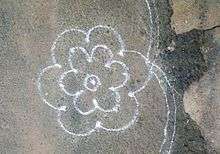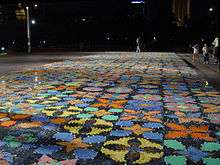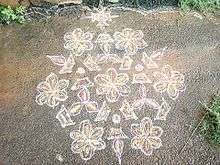Rangoli
Rangoli is an art form native to Nepal,[1][2] India and Bangladesh (known as Alpana)[3][4][5] in which patterns are created on the floor in living rooms or courtyards using materials such as colored rice, dry flour, colored sand or flower petals. It is usually made during Diwali or Tihar (collectively known as Deepawali) , Onam, Pongal and other Indian, Bangladeshi and Nepalese festivals related to Hinduism. Designs are passed from one generation to the next, keeping both the art form and the tradition alive.
The various names for this art form and similar practices include Kolam in Tamil Nadu, Mandana in Rajasthan, Chowkpurana in Chhattisgarh, Alpana in West Bengal, Aripana in Bihar, Chowk pujan in Uttar Pradesh, Muggu in Andhra Pradesh, Golam kolam or kalam in Kerala and others.[6]
The purpose of rangoli is decoration, and it is thought to bring good luck. Design depictions may also vary as they reflect traditions, folklore and practices that are unique to each area. It is traditionally done by women. Generally, this practice is showcased during occasions such as festivals, auspicious observances, marriage celebrations and other similar milestones and gatherings. In Nepal, Colorful rangoli are made from dyes and are lit up at night outside peoples homes and businesses.
Rangoli designs can be simple geometric shapes, deity impressions, or flower and petal shapes (appropriate for the given celebrations), but they can also be very elaborate designs crafted by numerous people. The base material is usually dry or wet powdered rice or dry flour, to which sindoor (vermilion), haldi (turmeric) and other natural colours can be added. Chemical colors are a modern variation. Other materials include colored sand, red brick powder and even flowers and petals, as in the case of flower rangolis.
Significance
Rangoli is derived from the Sanskrit word ‘rangavalli’. Rangoli is an art which precedes sculpture and painting. It is both an auspicious and a preliminary necessity in any religious ritual. The two aims of drawing rangoli:
- Beauty
- Auspiciousness/Spirituality
In different states
Rangoli art is an adornment or decoration that has different names in different states of India; for example, Rangoli in Karnataka, Chaookpurna in Chhattisgarh, Mandana in Rajasthan, Aripan in Bihar, Alpana in Bengal, Sanskar Bharti in Maharashtra, Kolam in Tamil Nadu, Muggulu in Andhra Pradhesh, Aipan in Kumaon, Kalam in Kerala, and Saathiya in Gujarat. Not just in names, the designs also vary as per the region.
In middle India mainly in Chhattisgarh Rangoli is called Chaook and is generally drawn at the entrance of a house or any other building. Dried rice flour or other forms of white dust powder is used for drawing Chaooks. Although there are numerous traditional Chaook patterns, many more can be created depending on the creativity of the person who draws it. It is considered auspicious as it signifies showering of good luck and prosperity on the house and in the family. It is not drawn like a picture. Patterns are created based on certain systems. Generally women get up early in the morning and clean the area just outside the entrance of their houses with cow dung, sprinkle the area with water and draw the Chaook. In Maharashtra, rangolis are drawn on the doors of homes so that evil forces attempting to enter are repelled. During the festival of Onam in Kerala, flowers are laid down for each of the ten days of the celebration, the design growing larger and more complex every day. In Tamil Nadu, Andhra Pradhesh and Karnataka, the Kolam is drawn upon the ground or floor daily. The designs are geometric and symmetrical मूल्यतः shapes but the materials used are similar rangoli: rice flour or slurry is used. In Rajasthan the Mandana are painted on walls. Mmandne, various festivals, major festivals and can be categorized based on seasons. Different shapes depending on the size of it also can be shared. Kumaon's "writing beat 'or in a variety of plotting symbols Thapa, artistic designs, Bellbutoan is used. Alikhthap of society apart - separated by different groups - different icons and art media is used.
Key elements
Rangoli's most important element is Utswdhermita. These are auspicious symbols that have a central role in the design. The design for generations are passed on as they are made - and is required to make these symbols. Traditionally, each new generation learns the art and thus a family keeps the tradition intact. Some major symbols used in Rangoli are the lotus flower, its leaves, mango, Tue vase, fish, different kind of birds like parrots, swans, peacocks, and human figures and foliage. Oftentimes Rangoli are made on special occasions like Diwali. Some special patterns for Diwali Rangoli are the Diya also called Deep, Ganesha, Lakshmi, flowers or birds of India.
The second key element is using the materials used to make the rangoli. The materials used are easily found everywhere. Therefore, this art is prevalent in all homes, rich or poor. Normally the major ingredients used to make rangoli are - Pise rice solution, dried powder made from the leaves color, charcoal, burned soil was, wood sawdust, etc..
The third important element is the background. Rangoli use the background of a clear floor or wall or Llype is used. Rangoli can be made in a yard in the middle, corners, or as a bell is created around. Dehri gateway is a tradition of making rangoli. God's seat, depending on lamp, place of worship and sacrifice on the altar is a tradition of decorating rangoli. With time, imagination and innovative ideas in Rangoli art is also incorporated. Hospitality and tourism has also had its effect and rangoli has been commercially developed in places such as hotels. Its traditional charm, artistry and importance still remain.
Rangoli is also created using coloured rice, dry flour, flower petals, turmeric (haldi), Vermillion (Sindoor) and coloured sand. The patterns include the face of Hindu deities, geometric shapes peacock motifs and round floral designs. Many of these motifs are traditional and are handed down by the previous generations. This makes rangoli a representation of India’s rich heritage and the fact that it is a land of festivals and colour.
Creation
There are two primary ways to make a Rangoli, dry and wet, referring to the materials used to create the outline and (if desired) fill that outline with colour. Using a white material like chalk, sand, paint or flour, the artist marks a centre-point on the ground and cardinal points around it, usually in a square, hexagon or circle depending on region and personal preference. Ramifying that initially-simple pattern creates what is often and intricate and beautiful design. Motifs from nature (leaves, petals, feathers) and geometric patterns are common. Less common but by no means rare are representational forms (like a peacock, icon or landscape). "Readymade Rangoli" patterns, often as stencils or stickers, are becoming common, making it easier to create detailed or precise designs.
Once the outline is complete, the artist may choose to illuminate it with colour, again using either wet or dry ingredients like paints, coloured rice-water, gypsum powder, coloured sand or dry pigments. The artist might also choose unprocessed materials like seeds, grains, spices, leaves or flower petals to achieve lifelike hues. Modern materials like crayons, dyes or dyed fabrics, acrylic paints and artificial colouring agents are also becoming common, allowing for brilliant and vibrant colour choices. A newer but less artificial method involves using cement coloured with marble powder. This rather precise method requires training, but beautiful portraits can be drawn in this medium.
Shape, design and material can be influenced by regional traditions. A square grid is common in North India as is a hexagonal grid in South India; Onam Rangolis are typically circular. In North India, the colour is most often based on gypsum (chirodi), in the South India on rice flour and Onam Rangolis are typically flower based. The rapid and widespread migration and mixing of people within India can be seen by the way these styles are now freely adopted and mixed across the country. It is also becoming common to see experimentation like sawdust-based floating Rangolis, freeform designs and exotic materials.
Faith and beliefs

In Tamil Nadu there is a prevalent myth, that Andaal worshipped Lord Thirumaal and was married to him in the month of Margazhi. So during this month, unmarried girls get up before dawn and draw a Rangoli to welcome the god Thirumal. Mentions of rangoli creation are also found in Hindu mythology. See also references to Rangoli in legend, such as in the - Ramayana at Sita's wedding pavilion where the discussion refers to rangoli there. Cultural development of Rangoli in the South originated in the era of the Chola Rulers. There are modern and traditional rangoli designs. The designs are usually inspired by nature, but they can also be in the form of abstract art.
 Rangoli is either left as uncoloured drawing or it is filled with various coloured powders
Rangoli is either left as uncoloured drawing or it is filled with various coloured powders.jpg) Rangoli of Global Events
Rangoli of Global Events Rangoli at Delhi
Rangoli at Delhi Rangoli at Chennai
Rangoli at Chennai Sankranti Muggu (Rangoli) with flowers
Sankranti Muggu (Rangoli) with flowers Rangoli with flowers at Chennai
Rangoli with flowers at Chennai- Rangoli at Nizampet, Hyderabad
 Rangoli before and after colouring
Rangoli before and after colouring Rangoli in Singapore
Rangoli in Singapore Alpana (painted Rangoli) in Rajshahi, Bangladesh
Alpana (painted Rangoli) in Rajshahi, Bangladesh Rangoli of Peocock in Tamil Nadu
Rangoli of Peocock in Tamil Nadu
 Nature Scene in Rangoli during a Vijayadashami festival, in Maharashtra
Nature Scene in Rangoli during a Vijayadashami festival, in Maharashtra A Tux rangoli by students at GNUnify'13, Pune
A Tux rangoli by students at GNUnify'13, Pune Rangoli is drawn in front of the house especially in festival days
Rangoli is drawn in front of the house especially in festival days Rangoli at Hyderabad
Rangoli at Hyderabad A rangoli made with flowers on the occasion of Onam
A rangoli made with flowers on the occasion of Onam Rangoli being prepared by a Rangoli mould vendor in Bangalore
Rangoli being prepared by a Rangoli mould vendor in Bangalore
References [7]
- ↑ "Significance of Tihar festival and Uses of Rangoli in Nepal".
- ↑ "Rangoli Celebrations in Durbar Square during Tihar festival of Nepal".
- ↑ http://en.banglapedia.org/index.php?title=Alpana
- ↑ http://www.bangladesh.com/blog/alpana-artistic-expressions-of-devotion
- ↑ http://www.craftrevival.org/CraftArt.asp?CountryCode=Bangladesh&CraftCode=003481
- ↑ "Kolams, chowkpurana, madana, aripana...". Rediff. Retrieved 12 January 2012.
- ↑ "Forum for Hindu Awakening". forumforhinduawakening.org. Retrieved 2016-01-15.
- Selvamony, Nirmal (2006). "Kalam as Heterotopia". In Muthukumaraswamy, M. D. Folklore as discourse. Chennai, India: National Folklore Support Centre. ISBN 81-901481-6-8.
Further reading
- Selin, Helaine (2008). Encyclopaedia of the History of Science, Technology, and Medicine in Non-Western Cultures, Volume 1. ISBN 140204559X. p. 1869-1870.
External links
| Wikimedia Commons has media related to Rangoli. |